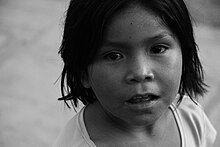|
Nahuas Gadis Nahua | |
Meksiko
Oaxaca, Morelos, Puebla, Hidalgo, Michoacán, Veracruz, Jalisco, Estado de México, Distrito Federal, Tlaxcala, Chihuahua, Durango, San Luis Potosi, dan Guerrero
El Salvador
Ahuachapan, Sonsonate, San Salvador, Santa Ana, | |
| Nahuatl dan Spanyol | |
| Kekristenan (sebagian besar Katolik), kepercayaan tradisional |
Nahua adalah kelompok penduduk asli di Meksiko dan El Salvador. Bahasa-bahasa mereka yang tergolong ke dalam rumpun bahasa Uto-Aztek,[1] yakni bahasa Nahuatl dan Pipil (Nawat), terdiri dari banyak dialek, dan tidak semua penuturnya bisa saling memahami. Sekitar 1,5 juta orang Nahua menuturkan bahasa Nahuatl, dan satu juta lainnya hanya menuturkan bahasa Spanyol. Di El Salvador, jumlah penutur asli nahuatl berada di bawah angka 1.000.[2] Orang-orang Nahua bermukim di empat wilayah utama; yaitu; Huasteca, Sierra de Puebla utara, Sierra de Puebla selatan, serta Morelos.[3]
Berdasarkan bukti-bukti yang ada, orang-orang Nahua berasal dari Aridoamerika, wilayah yang kini terletak di Meksiko barat laut. Mereka berpisah dari kelompok-kelompok penutur bahasa Uto-Aztek lainnya dan pindah ke bagian tengah Meksiko sekitar tahun 500 M. Pada pertengahan tahun 1980an hampir 50% populasi mereka meninggal, terutama karena penyakit pernapasan dan infeksi.[4]
Mereka menetap di Cekungan Meksiko dan wilayah sekitarnya, dan kemudian menyebar dan menjadi kelompok yang dominan di Meksiko tengah.
Catatan kaki
Daftar pustaka
- Canger, Una (1980). Five Studies Inspired by Náhuatl Verbs in -oa. Travaux du Cercle Linguistique de Copenhague, Vol. XIX. Copenhagen: The Linguistic Circle of Copenhagen; distributed by C.A. Reitzels Boghandel. ISBN 87-7421-254-0. OCLC 7276374.
- Canger, Una (1988). "Nahuatl dialectology: A survey and some suggestions". International Journal of American Linguistics. Chicago: University of Chicago Press. 54 (1): 28–72. doi:10.1086/466074. ISSN 0020-7071.
- Flores Farfán; José Antonio (2002). "The Use of Multimedia and the Arts in Language Revitalization, Maintenance, and Development: The Case of the Balsas Nahuas of Guerrero, Mexico" (PDF). Dalam Barbara Jane Burnaby; John Allan Reyhner. Indigenous Languages across the Community. Proceedings of the Annual Conference on Stabilizing Indigenous Languages (7th, Toronto, Ontario, Canada, May 11–14, 2000). Flagstaff, AZ: Center for Excellence in Education, Northern Arizona University. hlm. 225–236. ISBN 0-9670554-2-3. OCLC 95062129. [pranala nonaktif permanen]
- Friedlander, Judith (1975). Being Indian in Hueyapan: A Study of Forced Identity in Contemporary Mexico. New York: Saint Martin's Press.
- Fowler, William R., Jr. (1985). "Ethnohistoric Sources on the Pipil Nicarao: A Critical Analysis". Ethnohistory. Durham, NC: Duke University Press and the American Society for Ethnohistory. 32 (1): 37–62. doi:10.2307/482092. ISSN 0014-1801. JSTOR 482092. OCLC 62217753.
- Hill, Jane H.; Kenneth C. Hill (1986). Speaking Mexicano: Dynamics of Syncretic Language in Central Mexico. Tucson, AZ: University of Arizona Press. ISBN 0-8165-0898-4. OCLC 13126530.
- Kaufman, Terrence (2001). "The history of the Nawa language group from the earliest times to the sixteenth century: some initial results" (PDF) (edisi ke-Revised). Project for the Documentation of the Languages of Mesoamerica. Diarsipkan dari versi asli (PDF) tanggal 2020-01-19. Diakses tanggal 2007-10-07.
- Lockhart, James (1996). The Nahuas After the Conquest: A Social and Cultural History of the Indians of Central Mexico, Sixteenth Through Eighteenth Centuries. Stanford, CA: Stanford University Press. ISBN 0-8047-2317-6. OCLC 24283718.
- Restall, Matthew (2003). Seven Myths of the Spanish Conquest. Oxford and New York: Oxford University Press. ISBN 0-19-516077-0. OCLC 51022823.
- Sahagún, Bernardino de (1950–82) [ca. 1540–85]. Florentine Codex: General History of the Things of New Spain. vols. I-XII. Charles E. Dibble and Arthur J.O. Anderson (eds., trans., notes and illus.) (edisi ke-translation of Historia General de las Cosas de la Nueva España, 13 vols. in 12 hbk.). Santa Fe, NM and Salt Lake City: School of American Research and the University of Utah Press. ISBN 0-87480-082-X. OCLC 276351.
- Suárez, Jorge A. (1983). The Mesoamerian Indian Languages. Cambridge Languages Surveys series. London: Cambridge University Press. ISBN 0-521-22834-4.
- Weaver, Muriel Porter (1993). The Aztecs, Maya, and Their Predecessors: Archaeology of Mesoamerica (edisi ke-3rd). San Diego, CA: Academic Press. ISBN 0-01-263999-0.
|
